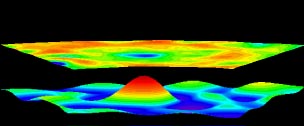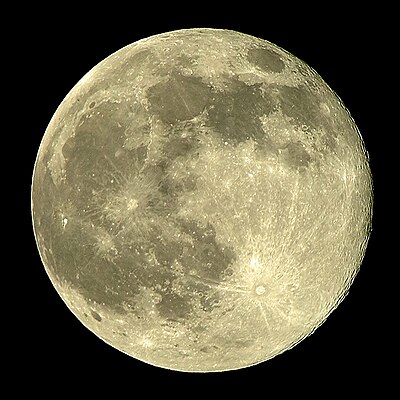Mare (moon)
The mare ( Latin , "sea", plural mare or Latin Maria with emphasis on the first syllable) refers to the dark plains of the moon , which when viewed with the naked eye, form the most striking feature of the surface.
One of the seas is called Oceanus ("ocean") because of its particularly large area : the Oceanus Procellarum .
Furthermore, there are structures on the lunar surface that are smaller than Maria, but otherwise have the same characteristics:
- Lacus (plural: lacūs , "lake"), smaller lava plains
- Palus (plural: paludes , "swamp"), unclear border areas of larger levels
- Sinus (plural: sinūs , "bay"), more or less circular bulges in a mare, mostly created by flooding with partial leveling of the wall of a large crater
distribution
Overall, the Maria occupy 16.9% of the lunar surface, whereby the distribution is very uneven: on the front they occupy 31.2%, on the back only 2.6%. The conspicuous grouping on the near-earth side is mostly in the northern half and forms the popularly so-called " moon face ".
Emergence
In the early days of lunar research, the dark areas were actually considered to be seas and were therefore referred to as Maria after Giovanni Riccioli .
In fact, the Maria are solidified layers of lava inside circular basins and irregular depressions. The depressions were probably caused by large impacts in the early phase of the moon. Since the moon's mantle was still liquid at this stage of development, its floors were then flooded by rising magma. The impact bodies changed the local gravity field of the moon and are still recognizable today as so-called mascons (from English mass concentration , "mass concentrations"). The lower crust thickness on the side of the moon facing the earth has strongly favored the magma outflows compared to those on the back. The dark mare stones are also referred to as Lunabas without obligation . The maria are covered by a layer of regolith 2 to 8 meters thick , rich in iron and magnesium .
The age of the dark basalts is 3.1 to 3.8 billion years. The plains have only a few craters and with the exception of these they show only very small differences in height of a maximum of 100 meters. These elevations include the dorsa . These flat, arching ridges extend over several dozen kilometers.
Interactive map
On this photo of the moon, the largest structures are linked to the corresponding Wikipedia entries. The names appear next to the cursor. The lunar axis is tilted about 45 degrees to the left in this picture. So it appears as it can be observed in mid-northern latitudes after its rise in the east.
In addition to the Maria, some craters and mountain ranges are shown.
See also
Web links
Spektrum.de : commented amateur recording



